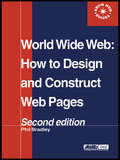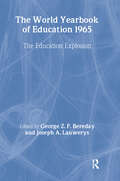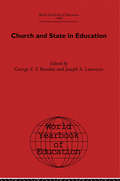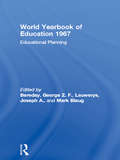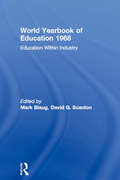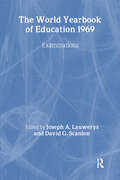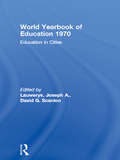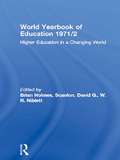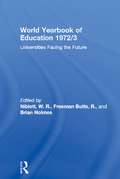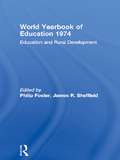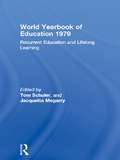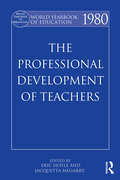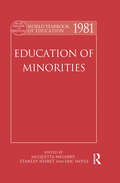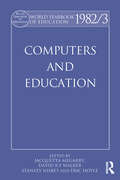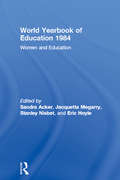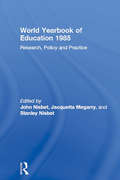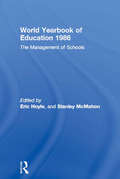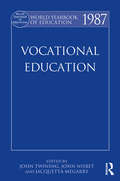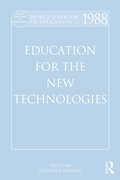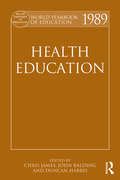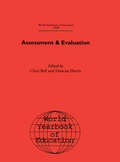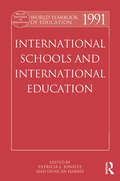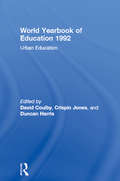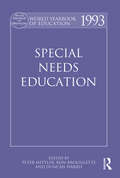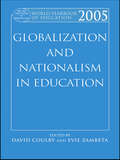- Table View
- List View
World Wide Web: How to design and Construct Web Pages
by Phil BradleyA practical introduction to the creation of Web pages, this title has been fully revised and expanded to include the most recent developments in HTML. As well as covering the design issues surrounding Web pages, it also includes sample HTML that can be incorporated into your pages, with worked examples. This second edition covers areas such as frames and tables, Java, and CGI scripts. Includes:1. What is the Internet, and where does the Web fit into it? 2. Using the World Wide Web as a Web author 3. First steps in designing your Web page 4. Working with the search engines 5. Writing Web pages 6. Forms 7. Tables 8. Colour on your pages 9. Frames 10. JavaScript and CGI 11. Meta tags 12. Publishing your pages 13. Authoring tools 14. Adding multimedia to a page 15. Further Resources Glossary
World Yearbook of Education 1965: The Education Explosion (World Yearbook of Education)
by George Z. F. Bereday Joseph A. LauwerysPublished almost every year since its beginnings four decades ago, The World Yearbook of Education has become one of the most established and respected international publications in education. Each edition focuses on a particular key issue and includes contributions from leading scholars. Now reprinted for 2006, all these classic references have become available to buy again.
World Yearbook of Education 1966: Church and State in Education (World Yearbook of Education)
by George Z. F. Bereday Joseph A. LauwerysFirst published in 2005. Broadly speaking, church-state relations in education turn nowadays upon two chief issues: I. Should religion be taught in state schools? And if so, may the state interfere with the teaching? 2. In countries where separate schools, under church control, exist should they have a share of public funds? Church and state issues flare up anew whenever there appears a repressive government action or a dynamic drive of the churches for a larger share of privileges. Both occur frequently enough to make this World Year Book a lively read.
World Yearbook of Education 1967: Educational Planning (World Yearbook of Education)
by Mark Blaug George Z. F. Bereday Joseph A. LauwerysFirst published in 2005. By focusing on planning this Year Book follows a tradition well established in Comparative Education. This year book hopes that by drawing together into one volume contributions from many distinguished specialists, it hopes to help in the necessary organization and systematization of a field which is full of promise.
World Yearbook of Education 1968: Education Within Industry (World Yearbook of Education)
by Joseph A. Lauwerys David G. Scanlon"First Published in 2005, Routledge is an imprint of Taylor & Francis, an informa company."
World Yearbook of Education 1969: Examinations (World Yearbook of Education)
by Joseph A. Lauwerys and David G. ScanlonFirst Published in 2005. Almost everywhere policies designed to broaden access to education and to promote equality of opportunity are now pursued. In consequence the importance of examinations grows, since success in them determines entry to higher education and thus to professional posts. They are therefore a major instrument of social mobility and promotion which affects social structure by applying criteria of selection nearly always accepted unconsciously and uncritically. The aim of this text in selecting Examinations as the theme of the 1969 WORLD YEAR BOOK, was to present a comparative analysis of the way in which examinations are devised, administered and assessed, to find out why we are examining, and to look at the ways in which we examine to see if these are efficient, relevant and reliable.
World Yearbook of Education 1970: Education in Cities (World Yearbook of Education)
by Joseph A. Lauwerys David G. Scanlon"First Published in 2005, Routledge is an imprint of Taylor & Francis, an informa company."
World Yearbook of Education 1971/2: Higher Education in a Changing World (World Yearbook of Education)
by W. R. Niblett Brian Holmes David G. ScanlonPublished in the year 2005, the World Yearbook of Education 1971/2 is a valuable contribution to the field of Major Works.
World Yearbook of Education 1972/3: Universities Facing the Future (World Yearbook of Education)
by Brian Holmes W. Roy Niblett R. Freeman Butts|Published in the year 2005, World Yearbook of Education 1972/3 is a valuable contrubtion to the field of Major Works.
World Yearbook of Education 1974: Education and Rural Development (World Yearbook of Education)
by Philip Foster James R. SheffieldPublished in the year 2005, World Yearbook of Education 1974 is a valuable contribution to the field of Major Works
World Yearbook of Education 1979: Recurrent Education and Lifelong Learning (World Yearbook of Education)
by Tom Schuller Jacquetta MegarryPublished in the year 2005, World Yearbook of Education 1979 is a valuable contribution to the field of Major Works.
World Yearbook of Education 1980: The Professional Development of Teachers (World Yearbook of Education)
by Eric Hoyle Jacquetta MegarryPublished in 2005, "World Yearbook of Education 1980" is an important contribution to the Major Works Series.
World Yearbook of Education 1981: Education of Minorities (World Yearbook of Education)
by JACQUETTA MEGARRY, STANLEY NISBET and ERIC HOYLEFirst Published in 2005. Routledge is an imprint of Taylor & Francis, an informa company.
World Yearbook of Education 1982/3: Computers and Education (World Yearbook of Education)
by Jacquetta MegarryThe World Yearbook of Education was first published by the Evans Brothers in 1965 in association with the University of London Institute of Education and Teachers College, Columbia University. Since then it has become established as one of the most important forums for work in comparative education in the world. Each volume addresses a major issue in comparative education and includes contributions from a range of leading international scholars. Subjects covered include: The impact of IT on education Gender, race and class in education Higher education Special educational needs and inclusive education Educational management
World Yearbook of Education 1984: Women and Education (World Yearbook of Education)
by Sandra Acker Eric Hoyle Jacquetta Megarry Stanley NisbetPublished in the year 2005, World Yearboook of Education 1984 is a valuable contribution to the field of Major Works.
World Yearbook of Education 1985: Research, Policy and Practice (World Yearbook of Education)
by Jacquetta Megarry Stanley Nisbet John NisbetPublished in the year 2005, World Yearbook of Education 1985, is a valuable contribution to the field of Major Works.
World Yearbook of Education 1986: The Management of Schools (World Yearbook of Education)
by Eric Hoyle Agnes McmahonPublished in the year 2005, World Yearbook of Education is a valuable contribution to the field of Major Works.
World Yearbook of Education 1987: Vocational Education (World Yearbook of Education)
by Jacquetta Megarry Stanley Nisbet John TwiningThe World Yearbook of Education was first published by the Evans Brothers in 1965 in association with the University of London Institute of Education and Teachers College, Columbia University. Since then it has become established as one of the most important forums for work in comparative education in the worldEach volume addresses a major issue in comparative education and includes contributions from a range of leading international scholars. The World Yearbook was originally published by Evans Brothers, then by Kogan Page and is now published by Routledge. It has not appeared in every year since its initial publication. This current collection will reprint all titles not currently available, from 1965
World Yearbook of Education 1988: Education for the New Technologies (World Yearbook of Education)
by Duncan HarrisPublished in the year 2005, World Yearbook of Education 1988 is a valuable contribution to Major Works.
World Yearbook of Education 1989: Health Education (World Yearbook of Education)
by Chris James Duncan Harris John BaldingPublished in 2005, "World Yearbook of Education 1989: Health Education is a valuable addition to the Major Works Series.
World Yearbook of Education 1990: Assessment & Evaluation (World Yearbook of Education)
by Chris Bell Duncan HarrisFirst Published in 2005. Routledge is an imprint of Taylor & Francis, an informa company.
World Yearbook of Education 1991: International Schools and International Education (World Yearbook of Education)
by Duncan Harris Patricia L. JonietzPublished in the year 2005, World Yearbook of Education 1991 is a valuable contribution to Major Works.
World Yearbook of Education 1992: Urban Education (World Yearbook of Education)
by David Coulby Duncan Harris Crispin JonesPublished in the year 2005, World Yearbook of Education is a valuable contribution to the field of Major Works.
World Yearbook of Education 1993: Special Needs Education (World Yearbook of Education)
by Peter Mittler Duncan Harris Ron BrouilletteFirst published in 2005. The goal of Education For All, set by the United Nations at the 1990 Jomtien (Thailand) Conference and adopted by heads of state at the World Summit for Children in the same year, confronts all of us with the fundamental challenge of including children with disabilities in the education system of all nations. The aim of this book is to record, analyse and celebrate positive signs of growth and development in the field of special needs education but with particular reference to children with significant disabilities. The special education theme was selected for the 1993 edition of The World Yearbook of Education in synchrony with the ending of the UN Decade of Disabled Persons, 1983 to 1992.
World Yearbook of Education 2005: Globalization and Nationalism in Education (World Yearbook of Education #Vol. 2005)
by David Coulby Evie ZambetaThis volume deals with two major and apparently opposing forces within education and society: globalization and nationalism. Globalization is often considered in economic terms - of continued growth of international trade and a concentration of wealth in corporate hands - yet it also encompasses technological, political and cultural change. The World Yearbook of Education 2005 explores the role of the education sector in our globalized knowledge economy, and considers the political implications of this in terms of monopolarity and the cultural consequences of homogenization and Americanization. The other strand of this study - nationalism - remains a persistent force within education and society in all parts of the world, and this volume examines the extent to which it can fuel conflict at all levels through prejudice and intolerance. Concentrating on the epistemological consequences of nationalism, leading international thinkers examine the extent to which it is reflected in the curricula of schools and universities around the world.Finally, the complex relationship between globalization and nationalism is explored, and contributors explore the part that educational institutions and practices play in forming both agendas. A wide range of perspectives are employed, including post-colonial discourse, classical economics and sociological theory.Nationalism and globalization are both ongoing processes, and this volume makes a case for the central role of education in both - through its potential to influence change and to act as benevolent force in shaping a global community.
